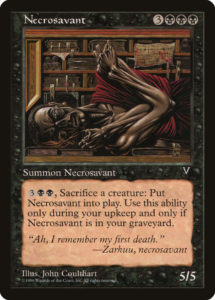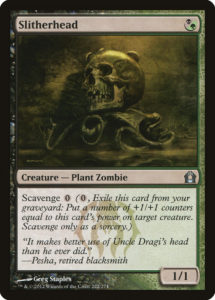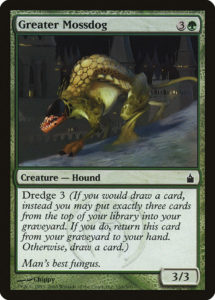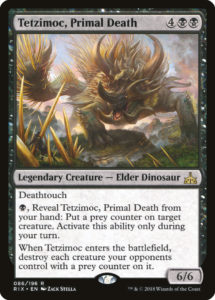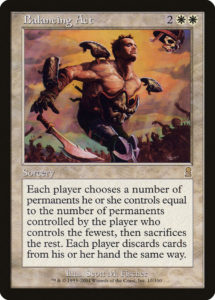Golgari tends to be incredibly powerful in Constructed while underwhelming in Limited, and that trend appears to continue with Guilds of Ravnica. The guild has always gotten an insanely powerful removal spell (Putrefy, Abrupt Decay, and now Assassin’s Trophy) along with a slew of powerful creatures (such as Golgari Grave-Troll, Deathrite Shaman, and Golgari Findbroker). I believe that there’s a causal and likely necessary reason for why Golgari’s dominance in Constructed invariably translates to weakness in Limited.
Golgari’s greatest strength is also the source of its consistent weakness: the graveyard.
Not dead for long
Golgari always gets a mechanic that cares about dead things. This makes perfect sense, since the guild’s purpose is to recycle the dead and forgotten into useful tools. Other guilds have not been so fortunate as to have a consistent, coherent mechanical identity—Radiance had nothing to do with being Boros, Cipher was weak and fragile but hardly stealthy, and Haunt took a cool name and concept and made something middling of it—but always being focused on the graveyard brings with it some challenges.
#1—Effort
Graveyards take time and effort to build up. Mechanics like Battalion, Evolve, and Bloodthirst are easier to employ, since they only require you to play creatures. Mechanics like Scavenge and Undergrowth require filling your graveyard with creatures, and enabling that requires one of two things—self-milling (which Golgari notably lacks at common in Guilds of Ravnica outside of Surveil) and trading creatures in combat. Golgari mages need to take extra steps to employ their set mechanics; and while Constructed players have access to the best self-mill around, Limited players are restricted to the speed of combat (which requires cooperation from the opponent). Golgari mages have to work harder than other kinds in order to take advantage of their cards.
This brings us to the second problem long-plaguing the Golgari.
#2—Rate
All three Golgari mechanics create long-game advantage, but this adds cost to each individual card, particularly at common. Greater Mossdog, Korozda Monitor, and Rhizome Lurcher are all underpowered cards at four mana unless the game has gone long. Drawing a guaranteed Hill Giant when you and your opponent are both topdecking is fine. But playing a Hill Giant on turn four hasn’t been a good line in a very long time, and Greater Mossdog wasn’t very good accordingly. Korozda Monitor provides card advantage, provided that the game goes very long. Rhizome Lurcher has the potential to be enormous, but you need to work to get a Hill Giant out of it on curve.
The fundamental problem of having a slow, effort-intensive mechanic is your cards are unimpressive until your engine revs up. Moreover, mechanics like Undergrowth will have more clunky, expensive cards so that players have a chance to turn them on on curve (unlike Scavenge and Unearth, where the benefit and a secondary cost come later). This all raises the question—why do Golgari creatures have to be below rate? We’ve seen Dimir have surprisingly excellent common creatures in GRN alongside a powerful, flexible mechanic (for the first time ever), so why not Golgari? The answer is simple: because it’s too dangerous.
#3—Interaction
The only zone in Limited that’s easy to interact with is the battlefield. The graveyard is difficult to touch. Some colors don’t get graveyard hate at all, and no format has ever been so skewed that packing pinpoint, maindeck graveyard interaction was a smart idea. (If I’m wrong please disabuse me of this notion, but I don’t think this was a good practice even in Odyssey block.) The graveyard is a resource that’s slow to build up, not always possible to use, and intentionally difficult to disrupt. It’s there for mechanics like Delve, Flashback, Threshold, and Undergrowth, not for players to constantly exile cards from for little to no benefit.
Mechanics that involve the graveyard run the risk of being brutally overpowered in Limited, particularly scaling mechanics like Undergrowth. If Rhizome Lurcher were a 3/3, then a single creature being in the graveyard makes it above rate. By trading a single creature, the Golgari mage’s creature went from being slightly below par to above it, and a second trade pushes them far ahead to victory. It suddenly becomes incorrect to interact with your opponent’s battlefield for fear of fueling Undergrowth. Scavenge was less dangerous because of the secondary (and often exorbitant) mana cost and the one-time benefit applied to the battlefield, which is the only zone in the game everyone gets to interact with.
Undergrowth cards have to be more expensive to compensate for how above rate they can become. Similarly, Golgari’s self-mill is weaker than ever (there’s no dredge or Grisly Salvage) because the ceiling of Undergrowth is higher in Limited than those of Dredge and Scavenge. This is also the reason why Glowspore Shaman is uncommon (even though it really looks like it should be the currently-missing common enabler)—it would make Undergrowth too easy to enable, too consistent, and do so at no cost (at least Grisly Salvage didn’t also put a creature into play). In Constructed, decks are supposed to be sleek and consistent, and if a graveyard deck is oppressive, well, there’s varying degrees of graveyard hate.
Good game design, particularly for competitive games, involves balancing acts. In order for Golgari to be playable in Standard and beyond, it needs powerful cards, ways to fuel and use its graveyard, and rewards for jumping through said hoops. However, its reliance on the graveyard would be easily oppressive in Limited; hence Golgari has always been the slow, awkward, grindy, graveyard guild.
Looking to the next time we see the Golgari—and to the Simic in the next set, who’ve never really gotten their fair chance in my book—I hope they enjoy a wonderfully designed twist, as Dimir, Boros, and Izzet received in GRN. All three received exciting new mechanics that play to their strengths and enabled new strategies. I’d love to see Golgari get Unearth, which would let them play a faster, more aggressive or sacrifice-focused game, or a mechanic like Morbid that involves death but not the graveyard. I’m not complaining about what Golgari has already, but it would be exciting to see them not be the slow, awkward guild in Limited whose strength comes from being underdrafted.
And, as always, thanks for reading.
—Zachary Barash
Zachary Barash is a New York City-based game designer and the commissioner of Team Draft League. He designs for Kingdom Death: Monster, has a Game Design MFA from the NYU Game Center, and does freelance game design. When the stars align, he streams Magic.
His favorite card of the month is Vedalken Entrancer. It’s a grindy, grindy card, combining reasonable but unexciting stats with a weak ability that can nevertheless win the game. It functions slowly enough to not take over the game, but its combination of defense and inevitability make for a solid card without being broken.

